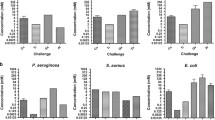Abstract
Basic chemistry of copper is responsible for its Janus-faced feature: on one hand, copper is an essential trace element required to interact efficiently with molecular oxygen. On the other hand, interaction with reactive oxygen species in undesired Fenton-like reactions leads to the production of hydroxyl radicals, which rapidly damage cellular macromolecules. Moreover, copper cations strongly bind to thiol compounds disturbing redox-homeostasis and may also remove cations of other transition metals from their native binding sites in enzymes. Nature has learned during evolution to deal with the dangerous yet important copper cations. Bacterial cells use different efflux systems to detoxify the metal from the cytoplasm or periplasm. Despite this ability, bacteria are rapidly killed on dry metallic copper surfaces. The mode of killing likely involves copper cations being released from the metallic copper and reactive oxygen species. With all this knowledge about the interaction of copper and its cations with cellular macromolecules in mind, experiments were moved to the next level, and the antimicrobial properties of copper-containing alloys in an “everyday” hospital setting were investigated. The alloys tested decreased the number of colony-forming units on metallic copper-containing surfaces by one third compared to control aluminum or plastic surfaces. Moreover, after disinfection, repopulation of the surfaces was delayed on copper alloys. This study bridges a gap between basic research concerning cellular copper homeostasis and application of this knowledge. It demonstrates that the use of copper-containing alloys may limit the spread of multiple drug-resistant bacteria in hospitals.

Similar content being viewed by others
References
Casey AL, Adams D, Karpanen TJ, Lambert PA, Cookson BD, Nightingale P, Miruszenko L, Shillam R, Christian P, Elliott TSJ (2010) Role of copper in reducing hospital environment contamination. J Hosp Inf 74:72–77
Dressler C, Kües U, Nies DH, Friedrich B (1991) Determinants encoding multiple metal resistance in newly isolated copper-resistant bacteria. Appl Environ Microbiol 57:3079–3085
Elguindi J, Wagner J, Rensing C (2009) Genes involved in copper resistance influence survival of Pseudomonas aeruginosa on copper surfaces. J Appl Microbiol 106:1448–1455. doi:10.1111/j.1365-2672.2009.04148.x
Haber F, Weiss J (1932) Über die Katalyse des Hydroperoxydes. Naturwissenschaften 20:948–950. doi:10.1007/BF0150471
Harrison JJ, Turner RJ, Joo DA, Stan MA, Chan CS, Allan ND, Vrionis HA, Olson ME, Ceri H (2008) Copper and quaternary ammonium cations exert synergistic bactericidal and antibiofilm activity against Pseudomonas aeruginosa. Antimicrob Agents Chemother 52:2870–2881
Housecroft CE, Constable EC (2006) Chemistry (3rd edn). Pearson Education Limited, Essex, England
Irving H, Williams RJP (1948) Order of stability of metal complexes. Nature 162:746–747
Magnani D, Solioz M (2007) How bacteria handle copper. In: Nies DH, Silver S (eds) Molecular microbiology of heavy metals. Springer-Verlag, Berlin, pp 259–285
Michels HT, Noyce JO, Keevil CW (2009) Effects of temperature and humidity on the efficacy of methicillin-resistant Staphylococcus aureus challenged antimicrobial materials containing silver and copper. Lett Appl Microbiol 49:191–195. doi:10.1111/j.1472-765X.2009.02637.x
Nies DH (1999) Microbial heavy metal resistance. Appl Microbiol Biotechnol 51:730–750
Nies DH (2007) Bacterial transition metal homeostasis. In: Nies DH, Silver S (eds) Molecular microbiology of heavy metals. Springer-Verlag, Berlin, pp 118–142
Noyce JO, Michels H, Keevil CW (2006) Use of copper cast alloys to control Escherichia coli O157 cross-contamination during food processing. Appl Environ Microbiol 72:4239–4244
Rogers J, Dowsett AB, Dennis PJ, Lee JV, Keevil CW (1994) Influence of temperature and plumbing material selection on biofilm formation and growth of Legionella pneumophila in a model potable water system containing complex microbial flora. Appl Environ Microbiol 60:1585–1592
Santo CE, Taudte N, Nies DH, Grass G (2008) Contribution of copper ion resistance to survival of Escherichia coli on metallic copper surfaces. Appl Environ Microbiol 74:977–986
Santo CE, Morais PV, Grass G (2010) Isolation and characterization of bacteria resistant to metallic copper surfaces. Appl Environ Microbiol 76:1341–1348. doi:10.1128/aem.01952-09
Weast RC (1984) CRC handbook of chemistry and physics, 64th edn. CRC Press, Inc., Boca Raton
Acknowledgments
We thank the German Copper Institute for financial support. We thank Ayla Nies for performing the silver experiment.
Author information
Authors and Affiliations
Corresponding author
Rights and permissions
About this article
Cite this article
Mikolay, A., Huggett, S., Tikana, L. et al. Survival of bacteria on metallic copper surfaces in a hospital trial. Appl Microbiol Biotechnol 87, 1875–1879 (2010). https://doi.org/10.1007/s00253-010-2640-1
Received:
Revised:
Accepted:
Published:
Issue Date:
DOI: https://doi.org/10.1007/s00253-010-2640-1




